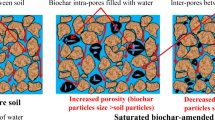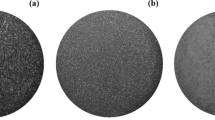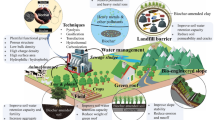Abstract
Biochar is a carbon-rich material obtained after thermochemical conversion of biomass under no oxygen environment. The effect of biochar amendment on soil properties, such as water retention, infiltration and desiccation crack potential was studied in the recent years. However, the effect of biochar or feedstock type on these properties is not explicit. This study investigates the effect of two different (in terms of feedstock) types of biochar on the water retention, infiltration and desiccation cracking behavior of compacted silty sand. Water retention characteristics, infiltration rate and the progression of desiccation cracks were measured after compacting soil amended with 5–10% (w/w) biochar produced from water hyacinth (WHB) and mesquite. Measurements were also taken for an unpyrolyzed material coir pith (CP, sourced from coconut husk)-amended soil for comparing the results of biochar-amended soil. The results show that the amendment of 5% to 10% biochar increased the maximum water holding capacity (θs), air entry value (AEV) and water content at 1500 kPa (θ1500) of the soil, whereas decreased the infiltration rate and peak crack intensity factor (CIF) of the soil. Moreover, the application of CP increased the infiltration rate. The amendment of WHB showed the highest increment in AEV and θ1500 and the highest decrement in infiltration rate and CIF compared to the other amendments. Based on the results, it is advisable to use the WHB-amended soil in bioengineered structures that could promote the growth of vegetation by higher water retention and could reduce the potential of leachate formation by decreasing water infiltration and desiccation crack potential.








Similar content being viewed by others
References
Abel S, Peters A, Trinks S, Schonsky H, Facklam M, Wessolek G (2013) Impact of biochar and hydrochar addition on water retention and water repellency of sandy soil. Geoderma 202:183–191
Ahmad M, Rajapaksha AU, Lim JE, Zhang M, Bolan N, Mohan D, Ok YS (2014) Biochar as a sorbent for contaminant management in soil and water: a review. Chemosphere 99:19–33
Albright WH, Benson CH, Gee GW, Abichou T, McDonald EV, Tyler SW, Rock SA (2006) Field performance of a compacted clay landfill final cover at a humid site. J Geotech Geoenviron 132(11):1393–1403
Andrenelli MC, Maienza A, Genesio L, Miglietta F, Pellegrini S, Vaccari FP, Vignozzi N (2016) Field application of pelletized biochar: Short term effect on the hydrological properties of a silty clay loam soil. Agr Water Manage 163:190–196
Angalaeeswari K, Kamaludeen SPB (2017) Production and characterization of coconut shell and mesquite wood biochar. Int J Chem Stud 5:442–446
ASTM C128–15. (2015) Standard test method for relative density (specific gravity) and absorption of fine aggregate. ASTM International, West Conshohocken, PA
ASTM D2487–11. (2011) Standard practice for classification of soils for engineering purpose (unified soil classification system). ASTM International, West Conshohocken, PA
ASTM D422–63 (2007) Standard test method for particle-size analysis of soils. ASTM Int West Conshohocken 10:1520
ASTM D4318–10 (2010) Standard test methods for liquid limit, plastic limit and plasticity index of soils. ASTM International, West Conshohocken, PA
ASTM D4972. (2018) Standard test method for pH of soils. West Conshohocken, PA
ASTM D698–12 (2012) Standard test methods for laboratory compaction characteristics of soil using standard effort. ASTM International, West Conshohocken, PA
ASTM D854 (2010) Standard test method for specific gravity of soil solids by water pycnometer. ASTM International, West Conshohocken, PA
ASTM E1755–01 (2007) Standard method for the determination of ash in biomass 2003 annual book of ASTM standards 11 05. ASTM International, Philadelphia, PA
Bird M, Keitel C, Meredith W (2017) Analysis of biochars for C, H, N, O and S by elemental analyser. In: Biochar: a guide to analytical methods. CSIRO publishing, Clayton, Australia, pp 39
Bordoloi S, Garg A, Sekharan S (2017a) A review of physio-biochemical properties of natural fibers and their application in soil reinforcement. Adv Civil Eng Mater 6(1):323–359
Bordoloi S, Hussain R, Garg A, Sreedeep S, Zhou WH (2017b) Infiltration characteristics of natural fiber reinforced soil. Transp Geotech 12:37–44
Bordoloi S, Hussain R, Gadi VK, Bora H, Sahoo L, Karangat R, Sreedeep S (2018a) Monitoring soil cracking and plant parameters for a mixed grass species. Géotech Lett 8(1):49–55
Bordoloi S, Garg A, Sreedeep S, Lin P, Mei G (2018b) Investigation of cracking and water availability of soil-biochar composite synthesized from invasive weed water hyacinth. Bioresour Technol 263:655–677
Busscher W, Novak J, Evans D, Watts D, Niandou M, Ahmedna M (2010) Influence of pecan biochar on physical properties of a Norfolk loamy sand. Soil Sci 175(1):10–14
Cao CT, Farrell C, Kristiansen PE, Rayner JP (2014) Biochar makes green roof substrates lighter and improves water supply to plants. Ecol Eng 71:368–374
Chen XW, Wong JTF, Ng CWW, Wong MH (2016) Feasibility of biochar application on a landfill final cover—a review on balancing ecology and shallow slope stability. Environ Sci Pollut R 23(8):7111–7125
Chen W, Meng J, Han X, Lan Y, Zhang W (2019) Past, present, and future of biochar. Biochar 1(1):75–87
Coles N, Trudgill S (1985) The movement of nitrate fertiliser from the soil surface to drainage waters by preferential flow in weakly structured soils, Slapton. S Devon Agr Ecosyst Environ 13(3–4):241–259
Corte A, Higashi A (1964) Experimental research on desiccation cracks in soil (No. RR-66). Cold Regions Research and Engineering Lab, Hanover, NH, USA
Costa S, Kodikara J, Shannon B (2013) Salient factors controlling desiccation cracking of clay in laboratory experiments. Géotechnique 63(1):18
de Melo Carvalho MT, Maia ADHN, Madari BE, Bastiaans L, Van Oort PAJ, Heinemann AB, Meinke H (2014) Biochar increases plant available water in a sandy soil under an aerobic rice cropping system. Solid Earth 6:887–917
Decagon Devices (2016) Operator’s manual version 2. MPS-2 & MPS-6 Dielectric Water Potential Sensors. Decagon Devices Inc., NE Nelson Court, Pullman, WA 99163, USA
Downie A, Crosky A, Munroe P (2009) Physical properties of biochar. Biochar for environmental management: Science Technology. Routledge, London, UK, pp 13–32
Feddes RA, Kowalik PJ, Zaradny H (1978) Simulation of field water use and crop yield. Centre for Agricultural Publishing and Documentation, Wageningen, Netherlands
Fellet G, Marchiol L, Delle Vedove G, Peressotti A (2011) Application of biochar on mine tailings: effects and perspectives for land reclamation. Chemosphere 83(9):1262–1267
Fodor N, Sándor R, Orfanus T, Lichner L, Rajkai K (2011) Evaluation method dependency of measured saturated hydraulic conductivity. Geoderma 165(1):60–68
Fredlund DG, Rahardjo H, Fredlund MD (2012) Unsaturated soil mechanics in engineering practice. Wiley, Hoboken
Gadi VK, Bordoloi S, Garg A, Sahoo L, Berretta C, Sekharan S (2017) Effect of shoot parameters on cracking in vegetated soil. Environ Geotech 5(2):1–31
Garg A, Leung AK, Ng CWW (2015) Transpiration reduction and root distribution functions for a non-crop species Schefflera heptaphylla. CATENA 135:78–82
Githinji L (2014) Effect of biochar application rate on soil physical and hydraulic properties of a sandy loam. Arch Agron Soil Sci 60(4):457–470
Goldsmith W, Silva M, Fischenich C (2001) Determining optimal degree of soil compaction for balancing mechanical stability and plant growth capacity (No. ERDC-TN-EMRRP-SR-26). Engineer research and development center. Vicksburg, MS environmental lab
Harshani HMD, Nawagamuwa UP, Senanayake A (2015) Evaluation of cover soil properties of solid waste dumpsites in Colombo district, Sri Lanka. J Nat Sci Found Sri Lanka 43:2
Hussain R, Garg A, Ravi K (2020a) Soil-biochar-plant interaction: differences from the perspective of engineered and agricultural soils. Bull Eng Geol Environ. https://doi.org/10.1007/s10064-020-01846-3
Hussain R, Ravi K, Garg A (2020) Influence of biochar on the soil water retention characteristics (SWRC): Potential application in geotechnical engineering structures. Soil Tillage Res 204:104713
Ibrahim HM, Al-Wabel MI, Usman AR, Al-Omran A (2013) Effect of Conocarpus biochar application on the hydraulic properties of a sandy loam soil. Soil Sci 178(4):165–173
Igalavithana AD, Ok YS, Niazi NK, Rizwan M, Al-Wabel MI, Usman AR, Lee SS (2017) Effect of corn residue biochar on the hydraulic properties of sandy loam soil. Sustainability 9(2):266
Indraratna B, Muttuvel T, Khabbaz H, Armstrong R (2008) Predicting the erosion rate of chemically treated soil using a process simulation apparatus for internal crack erosion. J Geotech Geoenviron Eng 134(6):837–844
Jeffery S, Meinders MB, Stoof CR, Bezemer TM, van de Voorde TF, Mommer L, van Groenigen JW (2015) Biochar application does not improve the soil hydrological function of a sandy soil. Geoderma 251:47–54
Lehmann J, Joseph S (2015) Biochar for environmental management: science, technology and implementation. Routledge, New York, USA
Lei O, Zhang R (2013) Effects of biochars derived from different feedstocks and pyrolysis temperatures on soil physical and hydraulic properties. J Soil Sediment 13(9):1561–1572
Li JH, Li L, Chen R, Li DQ (2016) Cracking and vertical preferential flow through landfill clay liners. Eng Geol 206:33–41
Lim TJ, Spokas KA, Feyereisen GW, Weis R, Koskinen WC (2017) Influence of biochar particle size and shape on soil hydraulic properties. J Environ Sci Eng 5(1):8–15
Major J, Rondon M, Molina D, Riha SJ, Lehmann J (2012) Nutrient leaching in a Colombian savanna Oxisol amended with biochar. J Environ Qual 41(4):1076–1086
Malik A (2007) Environmental challenge vis a vis opportunity: the case of water hyacinth. Environ Int 33(1):122–138
Moragues-Saitua L, Arias-González A, Gartzia-Bengoetxea N (2017) Effects of biochar and wood ash on soil hydraulic properties: a field experiment involving contrasting temperate soils. Geoderma 305:144–152
Ni J, Chen X, Ng C, Guo H (2018) Efects of biochar on water retention and matric suction of vegetated soil. Géotechnique Lett 8(2):124–129
Novak J, Sigua G, Watts D, Cantrell K, Shumaker P, Szogi A, Spokas K (2016) Biochars impact on water infiltration and water quality through a compacted subsoil layer. Chemosphere 142:160–167
Ouyang L, Wang F, Tang J, Yu L, Zhang R (2013) Effects of biochar amendment on soil aggregates and hydraulic properties. J Soil Sci Plant Nut 13(4):991–1002
Prober SM, Stol J, Piper M, Gupta VVSR, Cunningham SA (2014) Enhancing soil biophysical condition for climate-resilient restoration in mesic woodlands. Ecol Eng 71:246–255
Rasband WS (2011) ImageJ US National Institutes of Health, Bethesda, 616 Maryland, Astrophysics Source Code Library, USA
Reddy KR, Yargicoglu EN, Yue D, Yaghoubi P (2014) Enhanced microbial methane oxidation in landfill cover soil amended with biochar. J Geotech Geoenviron 140(9):04014047
Reddy KR, Yaghoubi P, Yukselen-Aksoy Y (2015) Effects of biochar amendment on geotechnical properties of landfill cover soil. Waste Manage Res 33(6):524–532
Rogovska N, Laird DA, Rathke SJ, Karlen DL (2014) Biochar impact on Midwestern Mollisols and maize nutrient availability. Geoderma 230:340–347
Spokas KA, Novak JM, Masiello CA, Johnson MG, Colosky EC, Ippolito JA, Trigo C (2014) Physical disintegration of biochar: an overlooked process. Environ Sci Tech Let 1(8):326–332
Suliman W, Harsh JB, Abu-Lail NI, Fortuna AM, Dallmeyer I, Garcia-Pérez M (2017) The role of biochar porosity and surface functionality in augmenting hydrologic properties of a sandy soil. Sci Total Environ 574:139–147
Tan X, Liu Y, Zeng G, Wang X, Hu X, Gu Y, Yang Z (2015) Application of biochar for the removal of pollutants from aqueous solutions. Chemosphere 125:70–85
Tang CS, Shi B, Liu C, Gao L, Inyang HI (2010) Experimental investigation of the desiccation cracking behavior of soil layers during drying. J Mater Civil Eng 23(6):873–878
Thomas GW (1982) Exchangeable cations. Methods of soil analysis. Part 2. Chemical and microbiological properties, (methodsofsoilan2). Amer Soc of Agron Inc.: Madison, Wisconsin, USA, pp 159–165
Uzoma KC, Inoue M, Andry H, Zahoor A, Nishihara E (2011) Influence of biochar application on sandy soil hydraulic properties and nutrient retention. J Food Agric Environ 9(3–4):1137–1143
van Genuchten M (1980) A closed-form equation for predicting the hydraulic conductivity of unsaturated soils. Soil Sci Soc Am J 44(5):892–898
van Genuchten MV, Leij FJ, Yates SR (1991) The RETC code for quantifying the hydraulic functions of unsaturated soils. USEPA, Washington, DC
Van Zwieten L, Kimber S, Morris S, Chan KY, Downie A, Rust J, Cowie A (2010) Effects of biochar from slow pyrolysis of papermill waste on agronomic performance and soil fertility. Plant Soil 327(1–2):235–246
Wall DK, Zeiss C (1995) Municipal landfill biodegradation and settlement. J Environ Eng 121(3):214–224
Williams JM, Latifi N, Vahedifard F (2018) In: Effects of biochar amendment on mechanical properties of buckshot clay. IFCEE, Orlando, Florida, pp 125–134
Wong JTF, Chen Z, Ng CWW, Wong MH (2016) Gas permeability of biochar-amended clay: potential alternative landfill final cover material. Environ Sci Pollut R 23(8):7126–7131
Wong JTF, Chen Z, Chen X, Ng CWW, Wong MH (2017) Soil-water retention behavior of compacted biochar-amended clay: a novel landfill final cover material. J Soil Sediment 17(3):590–598
Wong JTF, Chen Z, Wong AYY, Ng CWW, Wong MH (2018) Effects of biochar on hydraulic conductivity of compacted kaolin clay. Environ Pollut 234:468–472
Wu TH, McKinnell WP III, Swanston DN (1979) Strength of tree roots and landslides on Prince of Wales Island. Alaska Can Geot J 16(1):19–33
Wu P, Ata-Ul-Karim ST, Singh BP, Wang H, Wu T, Liu C, Chen W (2019) A scientometric review of biochar research in the past 20 years (1998–2018). Biochar 1(1):23–43
Yaghoubi P, Reddy KR (2011) Characteristics of biochar-amended soil cover for landfill gas mitigation. In Pan-Am CGS Geotechnical Conference
Yang X, Meng J, Lan Y, Chen W, Yang T, Yuan J, Han J (2017) Effects of maize stover and its biochar on soil CO2 emissions and labile organic carbon fractions in Northeast China. Agric Ecosyst Environ 240:24–31
Yargicoglu EN, Reddy KR (2017) Biochar-amended soil cover for microbial methane oxidation: effect of biochar amendment ratio and cover profile. J Geotech Geoenviron Eng 144(3):04017123
Yesiller N, Miller CJ, Inci G, Yaldo K (2000) Desiccation and cracking behavior of three compacted landfill liner soils. Eng Geol 57(1):105–121
Zong Y, Chen D, Lu S (2014) Impact of biochars on swell–shrinkage behavior, mechanical strength, and surface cracking of clayey soil. J Plant Nutr Soil Sc 177(6):920–926
Author information
Authors and Affiliations
Corresponding author
Rights and permissions
About this article
Cite this article
Hussain, R., Bordoloi, S., gupta, P. et al. Effect of biochar type on infiltration, water retention and desiccation crack potential of a silty sand. Biochar 2, 465–478 (2020). https://doi.org/10.1007/s42773-020-00064-0
Received:
Accepted:
Published:
Issue Date:
DOI: https://doi.org/10.1007/s42773-020-00064-0




